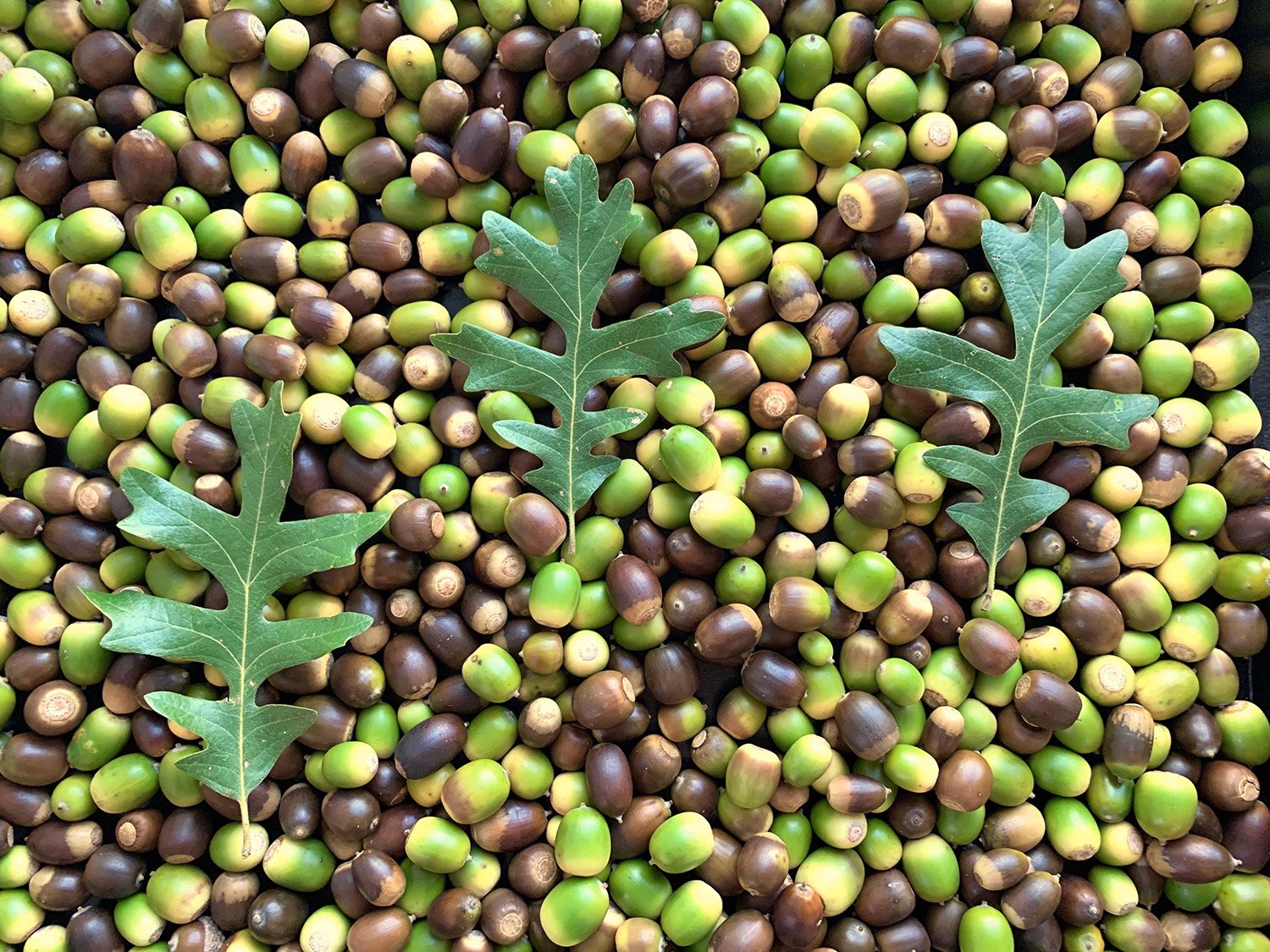Acorn Handling & Storage Tips
After more than 30 years of acorn collecting, I've learned things about acorn handling and storage that are neither obvious, nor commonly known, even among oak-cognoscenti. I've earned this knowledge honestly, and painfully.
While tens of thousands of cool and unusual oaks have been grown from acorns I've collected, there have been massive acorn losses along the way. Seems it is often easier to collect acorns than it is to handle and store them properly. I've killed tens of thousands of acorns, either by letting them be too wet, or too dry. Read on for an opportunity to learn from my successes and mistakes.
Often, collecting desirable acorns requires travel for hours. The timing of acorns ripening is never exact from year to year, so it is very possible to arrive at a producing, desirable oak, only to find the acorns are still green. If you can easily return in a week or two, then that's probably a good solution.
But what if you can't easily return? Or what if you are concerned that acorn predators may get to the ripening acorns before you are able to return? If the green acorns are accessible to picking, you may be able to collect nearly-ripe green acorns, if you are observant and careful.
The key to early picking is a part of the acorn called the hilum. The hilum is the connection between the acorn and its cup, or cap. This is the circle of light colored material at the "top" of a ripe acorn.
The way to know if a green acorn is sufficiently ripe to pick is simple. Grasp an accessible green acorn on a desired oak, holding the green acorn in the fingertips of one hand, while holding the acorn cup in the fingertips of the other hand. Twist.
If the hilum stays with the cup, ripping the hilum from the acorn top, the acorn is destroyed, and will rot. But if the acorn releases cleanly, and the hilum stays intact on the acorn as intended, that acorn is sufficiently ripe to pick, though it is not yet fully ripened. Fully ripened acorns are brownish in color.
So how do you get those sufficiently-ripened green acorns to fully ripen to brown? You have to dry them, slowly and carefully. Green acorns are full of moisture which must be gradually released, and the acorns gradually turn brown.
Dry the acorns too much, and the acorn shell turns tan on the outside. Tan colored acorns must be opened to check for viability - cutting a sample of tan acorns open allows checking the health of the acorn meat. With dead and desiccated acorns, either the embryo dies and turns dark, or the stored carbohydrate in the acorn pericarp turns dark, or both. Healthy acorn meat should be on the whitish or yellowish side. The only way to know the condition of the acorn meat inside a tan colored acorn is to look.
Please always keep in mind that an acorn is a living organism - or at least the embryo at the tip of the acorn is. Like any living organism, an acorn must maintain homeostasis, which includes maintaining a livable range of humidities. Too much humidity kills, and so does too little. Learning the balance is the trick.
With green acorns, I have found that simply letting picked the green acorns air dry in the house works fine, so long as there is good air movement over all the acorns. Something like a baking tray has proven ideal.
In the past, I have tried ripening green acorns in a bowl, but the acorns were 5 or more layers deep within the bowl, and the acorns at the bottom didn't have good air flow. So the air at the bottom became overly humid, and the lower levels of acorns rotted. From this experience I learned to only allow drying acorns to be one or two layers deep.
Next, let's consider what happens if you collect green acorns into a clear plastic bag, and seal the bag. Once sealed, you will soon see moisture collecting on the inside of the plastic bag. If this moisture is allowed to build up, and the temperature is above roughly 38 degrees F, your sealed plastic bag of acorns will shortly turn into a sealed plastic bag of mold.
So, obviously, don't keep green acorns in a sealed plastic bag. Even if you leave the plastic bag of green acorns open, you will still likely lose to the acorns toward the bottom of the bag to mold before they are able to turn brown, again due to high humidities and poor air circulation.
Avoiding these mistakes, you've dried your your green acorns to a nice, even brown. So what is next in our acorn storage adventure? For better or for worse, even brown acorns give off a small amount of moisture, at least until they are fully and truly ripe.
To make this idea clear, let's say you put a closed, clear plastic bag of brown acorns in the fridge. What happens? Unless the brown acorns are right at the edge of desiccation, you will get moisture condensation in the bag with the acorns. A little bit of condensation in the bag with the brown acorns is typically ideal, as this will keep the acorns from fully desiccating in storage, which is yet another way to kill acorns in storage.
If you find a lot of condensation in the clear, closed plastic bag of brown acorns, you had best get that moisture out. If you don't, your acorns could start germinating, or they could start molding. Mold in bagged acorns typically starts at the hilum, the most vulnerable part of the acorn. Mold can also start on the emerging radical of any germinating acorn.
Sometimes TEMPORARILY storing brown acorns in OPEN plastic bags in the fridge is a good strategy. But it must be remembered that a refrigerator is actually a kind of dehydrator, and you can easily dry your acorns to death in a refrigerator. So if you leave brown acorns in an open bag in the refrigerator, they will dry out and die.
Storing acorns in a paper bag is the same as storing them in the air. Acorns will dry out and die if left in paper bags for any length of time. Do not store acorns in paper bags, either in the refrigerator, or in ambient air conditions.
Keep acorns at a consistent temperature for storage, with 38 degrees F being a good target temperature. If the refrigerator that the acorns are being stored in loses power - say there is a planned power shutoff due to wildfire threat - the fridge warms, and the acorns receive the germination signal. Moisture and heat drive germination.
Seeing a germinated acorn in a bag in the fridge can be exciting, but that emerging radical gets moldy very easily, and molds much more easily than an intact acorn. Maintaining germinated acorns in a fridge is a greater challenge than simply maintaining whole, unopened acorns in the fridge.
Finally, you want to avoid having wet bags of acorns near the back of the fridge where temperatures are lower, and you can get ice build-up in the bags.


